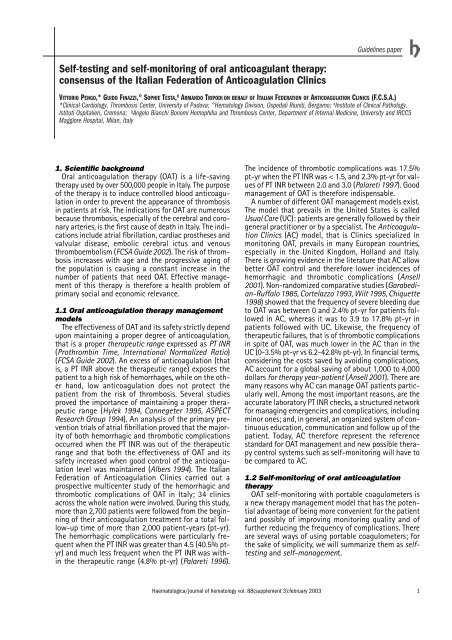Haematologica 2003 - Supplements - Haematologica
Haematologica 2003 - Supplements - Haematologica
Haematologica 2003 - Supplements - Haematologica
You also want an ePaper? Increase the reach of your titles
YUMPU automatically turns print PDFs into web optimized ePapers that Google loves.
Self-testing and self-monitoring of oral anticoagulant therapy:consensus of the Italian Federation of Anticoagulation ClinicsGuidelines paperVITTORIO PENGO,* GUIDO FINAZZI,° SOPHIE TESTA, # ARMANDO TRIPODI ON BEHALF OF ITALIAN FEDERATION OF ANTICOAGULATION CLINICS (F.C.S.A.)*Clinical Cardiology, Thrombosis Center, University of Padova; °Hematology Division, Ospedali Riuniti, Bergamo; # Institute of Clinical Pathology,Istituti Ospitalieri, Cremona; §Angelo Bianchi Bonomi Hemophilia and Thrombosis Center, Department of Internal Medicine, University and IRCCSMaggiore Hospital, Milan, Italy1. Scientific backgroundOral anticoagulation therapy (OAT) is a life-savingtherapy used by over 500,000 people in Italy. The purposeof the therapy is to induce controlled blood anticoagulationin order to prevent the appearance of thrombosisin patients at risk. The indications for OAT are numerousbecause thrombosis, especially of the cerebral and coronaryarteries, is the first cause of death in Italy. The indicationsinclude atrial fibrillation, cardiac prostheses andvalvular disease, embolic cerebral ictus and venousthromboembolism (FCSA Guide 2002). The risk of thrombosisincreases with age and the progressive aging ofthe population is causing a constant increase in thenumber of patients that need OAT. Effective managementof this therapy is therefore a health problem ofprimary social and economic relevance.1.1 Oral anticoagulation therapy managementmodelsThe effectiveness of OAT and its safety strictly dependupon maintaining a proper degree of anticoagulation,that is a proper therapeutic range expressed as PT INR(Prothrombin Time, International Normalized Ratio)(FCSA Guide 2002). An excess of anticoagulation (thatis, a PT INR above the therapeutic range) exposes thepatient to a high risk of hemorrhages, while on the otherhand, low anticoagulation does not protect thepatient from the risk of thrombosis. Several studiesproved the importance of maintaining a proper therapeuticrange (Hylek 1994, Cannegeter 1995, ASPECTResearch Group 1994). An analysis of the primary preventiontrials of atrial fibrillation proved that the majorityof both hemorrhagic and thrombotic complicationsoccurred when the PT INR was out of the therapeuticrange and that both the effectiveness of OAT and itssafety increased when good control of the anticoagulationlevel was maintained (Albers 1994). The ItalianFederation of Anticoagulation Clinics carried out aprospective multicenter study of the hemorrhagic andthrombotic complications of OAT in Italy; 34 clinicsacross the whole nation were involved. During this study,more than 2,700 patients were followed from the beginningof their anticoagulation treatment for a total follow-uptime of more than 2,000 patient-years (pt-yr).The hemorrhagic complications were particularly frequentwhen the PT INR was greater than 4.5 (40.5% ptyr)and much less frequent when the PT INR was withinthe therapeutic range (4.8% pt-yr) (Palareti 1996).The incidence of thrombotic complications was 17.5%pt-yr when the PT INR was < 1.5, and 2.3% pt-yr for valuesof PT INR between 2.0 and 3.0 (Palareti 1997). Goodmanagement of OAT is therefore indispensable.A number of different OAT management models exist.The model that prevails in the United States is calledUsual Care (UC): patients are generally followed by theirgeneral practitioner or by a specialist. The AnticoagulationClinics (AC) model, that is Clinics specialized inmonitoring OAT, prevails in many European countries,especially in the United Kingdom, Holland and Italy.There is growing evidence in the literature that AC allowbetter OAT control and therefore lower incidences ofhemorrhagic and thrombotic complications (Ansell2001). Non-randomized comparative studies (Garabedian-Ruffalo1985, Cortelazzo 1993, Wilt 1995, Chiquette1998) showed that the frequency of severe bleeding dueto OAT was between 0 and 2.4% pt-yr for patients followedin AC, whereas it was to 3.9 to 17.8% pt-yr inpatients followed with UC. Likewise, the frequency oftherapeutic failures, that is of thrombotic complicationsin spite of OAT, was much lower in the AC than in theUC (0-3.5% pt-yr vs 6.2-42.8% pt-yr). In financial terms,considering the costs saved by avoiding complications,AC account for a global saving of about 1,000 to 4,000dollars for therapy year-patient (Ansell 2001). There aremany reasons why AC can manage OAT patients particularlywell. Among the most important reasons, are theaccurate laboratory PT INR checks, a structured networkfor managing emergencies and complications, includingminor ones; and, in general, an organized system of continuouseducation, communication and follow up of thepatient. Today, AC therefore represent the referencestandard for OAT management and new possible therapycontrol systems such as self-monitoring will have tobe compared to AC.1.2 Self-monitoring of oral anticoagulationtherapyOAT self-monitoring with portable coagulometers isa new therapy management model that has the potentialadvantage of being more convenient for the patientand possibly of improving monitoring quality and offurther reducing the frequency of complications. Thereare several ways of using portable coagulometers; forthe sake of simplicity, we will summarize them as selftestingand self-management.<strong>Haematologica</strong>/journal of hematology vol. 88(supplement 3):february <strong>2003</strong> 1
















